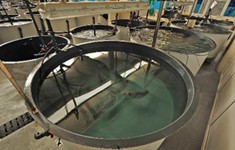 quaculture producers in Southeast Asia are proving reluctant to find alternative feeds even as the price of fishmeal continues to soar, according to a veteran watcher of the sector.
quaculture producers in Southeast Asia are proving reluctant to find alternative feeds even as the price of fishmeal continues to soar, according to a veteran watcher of the sector.“It used to be inexpensive and plentiful, and as a result it was widely used in aquafeeds … However the economics and availabilities of fishmeal have changed and there needs to be a move away to using other ingredients to save money and for other ecological reasons … also, many certification programs also demand a reduction,” said Lukas Manomaitis, an aquaculture and seafood consultant at Bangkok-based Seafood Consulting Associates.
Low global inventories and restricted fishing quotas in key producers like Peru have driven fishmeal prices to historic highs. Yet aquaculture producers in Southeast Asia remain reluctant to change old habits and try alternatives like soy, Manomaitis said.
“Fishmeal is a very good ingredient for aquafeeds because … it doesn’t require a lot of work in formulation,” he said. “As in so many cases, the new feeds may perform as well, or even better, than the old feeds, but farmers are conservative and think that they have to have something that looks and smells the same for it to be good. Farmers now expect that feeds will smell ‘fishy.’”
Aside from feed, the aquaculture sector in Southeast Asia has other problems to fix in order to compete with Chinese output. Compared to China, the marine aquaculture sector in general in Southeast Asia remains still fairly weak when it comes to marine aquaculture.
“The reasons for this are many, but in Indonesia it breaks down to lack of quality fingerlings, a lack of proper culture approach and a lack of security,” Manomaitis said. “Also, there is still a very strong wild fishery.”
Aquaculture in the region needs to better focus on the genetics of brood stock, said Manomaitis.
“Inbreeding, lack of strain development and no genetics plan has led to many hatcheries producing sub-optimal qualities and quantities of fingerlings,” he said. “Disease is an issue, where some disease is coming right from the hatchery to the farms. So a good health management program is key … Feeds could be improved as well.”
To increase the use of fishmeal alternatives, Manomaitis said he believes sales and technical staff will have to be on hand to show that feeds “that do not look or smell like they used to will perform just as well.” Rising soybean prices due to tight supply in the 2012 harvest means soybeans have become a slightly less attractive replacement, but Manomaitis (who also represents the U.S. soybean export sector in the region) said prices look set to soften this year in line with increased supply, and he expects an upsurge in soy replacement of fishmeal in 2013.
“The key issue in the past year was the tightness of the soy market due to drought and floods in every major production area for soy — and India selling on a barter (oil seeds, grain for oil) system to Iran,” he said. “With good crops in Brazil and Argentina this year I expect that for the short to medium term the tightness will decrease … we have to see what happens with the drought situation in U.S. this year though.”
The U.S. Department of Agriculture estimated in February that China might import 63 million metric tons of soybeans in 2012/13. China tends to base its purchases around drops in price in major export markets like the U.S.





